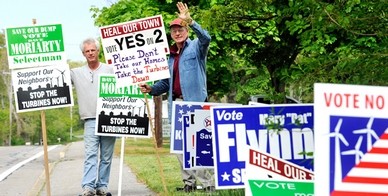Falmouth turbines to stay, Fairhaven turbines too loud
Human impacts, News, Wind turbines Add comments In the first town-wide vote on the question of what to do about noise issues around two town-owned turbines, Falmouth voters overwhelmingly defeated a measure that would have authorized the Selectmen to continue on their preferred path of dismantling the turbines. The proposal carried a likely pricetag of about $800 per household, spread over ten years, largely to pay back loans and renewable energy credits that the town received in advance in order to buy and install the turbines. The measure fell by a 2-1 margin, with about 40% of the town’s registered voters turning out.
In the first town-wide vote on the question of what to do about noise issues around two town-owned turbines, Falmouth voters overwhelmingly defeated a measure that would have authorized the Selectmen to continue on their preferred path of dismantling the turbines. The proposal carried a likely pricetag of about $800 per household, spread over ten years, largely to pay back loans and renewable energy credits that the town received in advance in order to buy and install the turbines. The measure fell by a 2-1 margin, with about 40% of the town’s registered voters turning out.
Board of Selectmen Chairman Kevin Murphy said that the board will now begin looking at other ways to try to address the long-simmering dispute. About 40 households have formally filed complaints, representing 15-20% of the homes within about a half mile. Since noise monitoring showed some violations of state noise limits, the two turbines do not run at night, so operate at a loss to the town, though they still produce carbon-free electricity for use at the town’s wastewater treatment plant.
For more on the Falmouth vote, see coverage in the Cape Cod Times and from the AP.
UPDATE, 5/25/13: Three neighbors respond to the vote in this local article.
UPDATE, 6/5/13: Neighbors emphasize that the vote was about funding the previous decision of the Selectmen to take the turbines down (not about whether the turbines should operate), and that the problems will need to be addressed by the incoming Board of Selectmen and/or the Board of Health. They also say the state should step up with some financial help or forgiveness to lessen the burden on town taxpayers.
UPDATE, 7/5/13: The Board of Selectmen have begun discussing their options for resolving the turbine issue. See local coverage of their first public discussion here and here.
Across the bay in Fairhaven, the first results of noise testing were announced at a Board of Health meeting, marking a turning point not unlike one Falmouth encountered about a year ago. Monitoring by the state Department of Environmental Protection has found that the two turbines in Fairhaven exceeded state noise limits in 5 of the 24 testing periods analyzed so far (more testing in varying wind conditions is ongoing). All of the violations ranged from 0.7-1.5dB over the limit of 10dB above background ambient conditions. Two to three decibels is considered the threshold of the human ear being able to hear an audible difference, so these noise levels are not perceptibly louder than sound just below the 10dB threshold; however, we once again see evidence that the 10dB-over-ambient standard is pushing the tolerance of neighbors. As Fairhaven board of Selectman Chairman Charlie Murphy said, “Before, people didn’t believe the turbines were that loud at night, but now the study shows it,” adding that the results leave him more determined to “give our residents a good night’s sleep.”
As in Falmouth, where violations were also found in only some conditions and just over the limits, dozens of neighbors are complaining of lost sleep and other related health issues. EPA standards developed in the 1970’s suggested that noise sources are fairly well tolerated when they remain within 5dB of existing ambient levels, and that at 10dB above ambient, “widespread complaints” are likely. The detailed results from Fairhaven were not released, but the Falmouth report showed all locations exceeding 5dB, and most exceeding 7dB. Some states still use 5-6dB thresholds, though many have moved to the 10dB used in Massachusetts, or refrain from the difficult task of regulating noise based on ambient conditions. The Massachusetts measurement protocol has elements that may in part compensate for the larger 10dB threshold, and other elements that could counter that compensation: the standard compares the L90 sound level (quietest times) of ambient conditions with the absolute peak sound levels of noise from the turbines, rather than the average of each, which may somewhat increase the dB difference; however, the use of “slow” five-second time averaging, rather than “fast” one-second samples (closer to how the human ear perceives sound) likely results in lower peak measurements. Again, though, quibbling over exactly how the measurements take place can obscure the larger issue, which is that current standards appear to be insufficient to keep complaints to a minimum.
